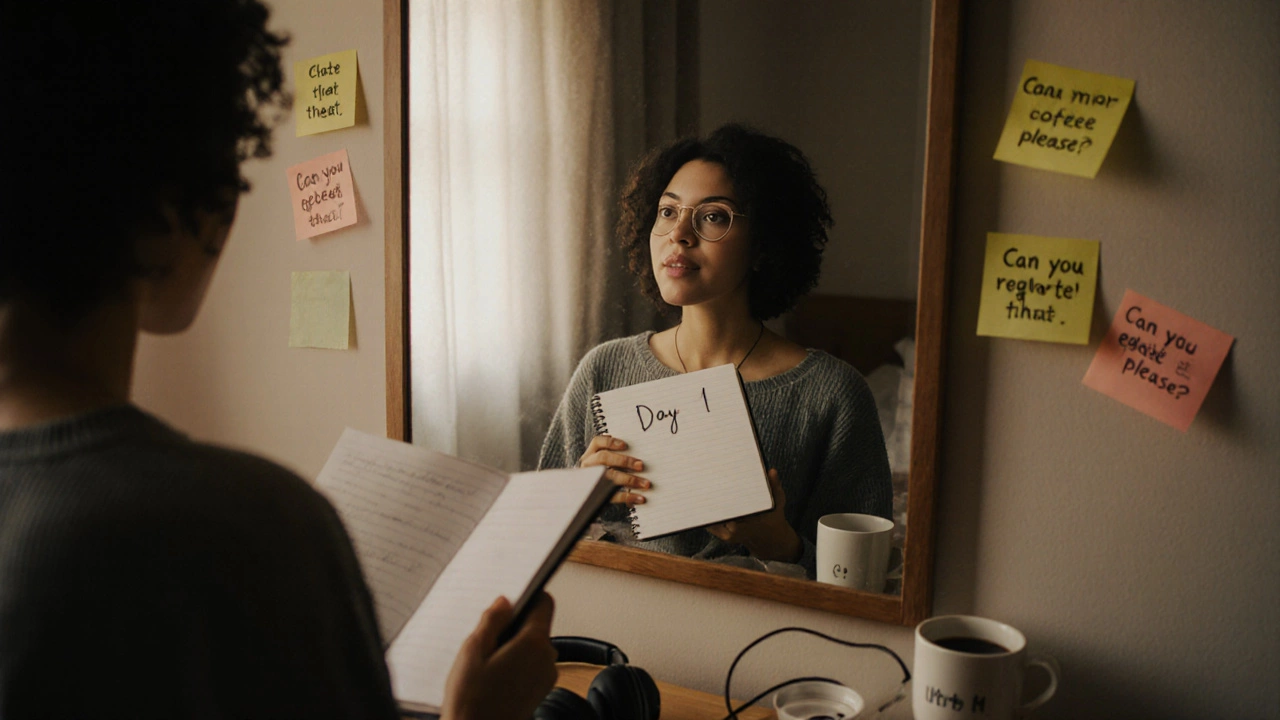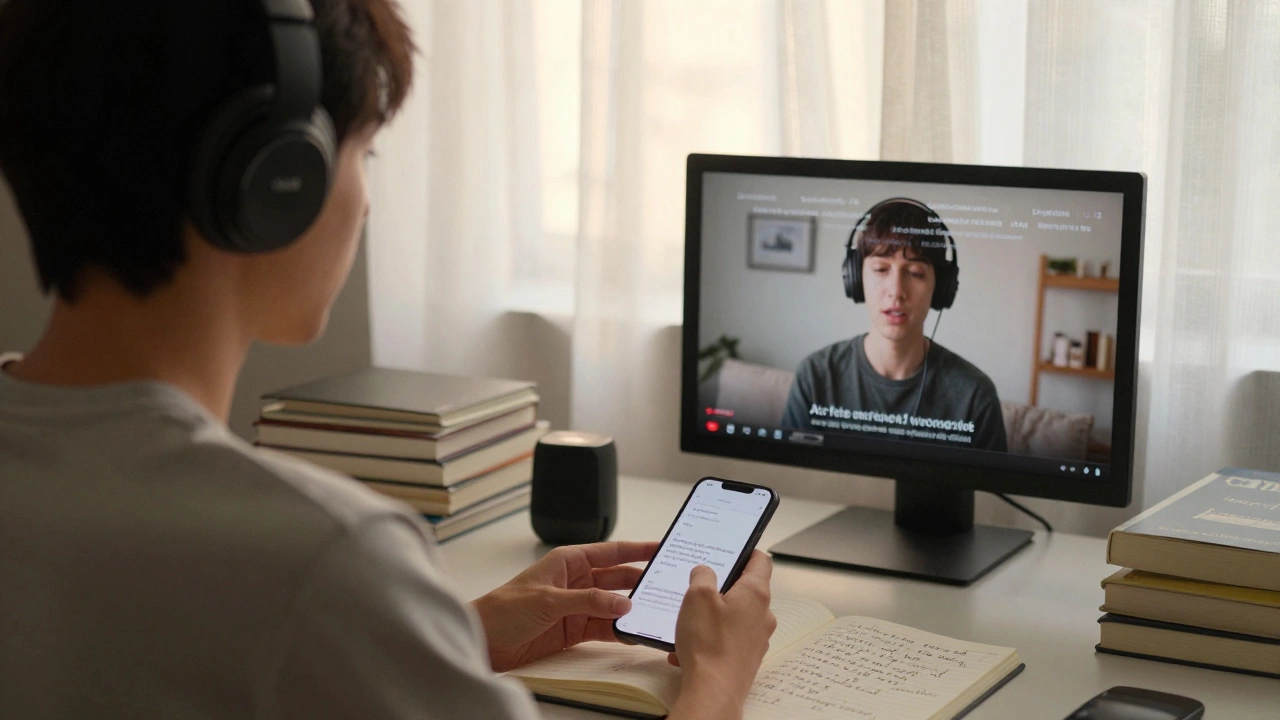How to Speak English Fluently in 10 Days: A Realistic Step-by-Step Plan

10-Day English Fluency Tracker
Daily Progress
Day 1: Survival Phrases
Practice these 5 phrases out loud until automatic: "Can you repeat that?", "What does [word] mean?", "I'm learning English", "How do you say [something]?", "That makes sense - thanks!"
Day 2: Listen Like a Detective
Watch a 5-minute clip without subtitles. Write down what you catch. Listen again with subtitles. Focus on connected speech patterns.
Day 3: Speak to Yourself
Talk to yourself in front of a mirror. Describe your day using simple words. Don't worry about grammar.
Day 4: Record Yourself
Record your voice talking about your day. Listen back and adjust your rhythm and speed.
Day 5: Find a Conversation Partner
Connect with someone for a 10-minute conversation on an app like Tandem or HelloTalk.
Day 6: Think in English
Label objects around you in English. Think simple phrases instead of translating from your native language.
Day 7: Shadowing Technique
Listen to a 30-second clip, pause, and repeat exactly what you hear. Copy the rhythm and tone.
Day 8: Speak Like You're in a Hurry
Set a timer for 60 seconds. Talk non-stop about any topic. Don't stop if you make mistakes.
Day 9: Build Confidence
Continue daily practice. Focus on speaking without overthinking. You're building a habit.
Day 10: The Real Test
Have a 15-minute conversation with someone. Don't mention you're practicing. Be confident!
Daily Speaking Time
Can you really learn to speak English fluently in 10 days? Most people say no. But if you’re willing to drop perfection, ignore grammar drills, and focus only on what actually gets you understood - then yes, you can make massive progress. Not because you’ve mastered the language, but because you’ve learned how to use it. This isn’t about becoming a poet. It’s about ordering coffee, asking for directions, and having a real conversation without freezing up.
Forget textbooks. Start with survival phrases.
Day 1 isn’t about learning the past tense. It’s about learning how to survive your first real interaction. Write down these five phrases and say them out loud until they feel automatic:
- Can you repeat that, please?
- What does [word] mean?
- I’m learning English. Can you speak slowly?
- How do you say [something] in English?
- That makes sense - thanks!
These aren’t fancy. They’re tools. Every native speaker you talk to will appreciate you using them. You’re not pretending to be fluent. You’re being smart. And that’s the first step to sounding fluent.
Listen like a detective - not a student.
On Day 2, stop watching English videos with subtitles. Instead, pick one 5-minute clip from a YouTube vlogger, podcast, or Netflix show. Play it once without subtitles. Write down every word you catch. Then play it again with subtitles. Circle the words you heard correctly. Now listen a third time - focus only on the sounds between the words. How do they connect? "I want to" becomes "I wanna." "Do you want" turns into "D’you wanna?"
This is called connected speech. Native speakers don’t say words one by one. They smash them together. If you don’t train your ear to hear this, you’ll understand nothing in real life - even if you know all the vocabulary.
Repeat this process daily with different clips. By Day 5, you’ll start recognizing patterns. That’s when your brain stops translating and starts understanding.
Speak to yourself - out loud, every day.
Day 3 is when most people quit. They think they need a partner. They don’t. You need a mirror.
Stand in front of it. Talk about your day. "I woke up at 7. I drank coffee. I felt tired." Don’t worry about grammar. Don’t worry about mistakes. Just keep talking. Use simple words. Use gestures. Make it real.
On Day 4, record yourself. Play it back. Don’t cringe. Listen for rhythm. Are you speaking too fast? Too slow? Do you pause too much? Adjust. Repeat the same sentence 10 times until it flows. Your voice doesn’t need to sound perfect. It needs to sound consistent.
This isn’t practice. It’s muscle training. Your mouth and tongue are learning new movements. Just like a runner trains for a race, you’re training your speech muscles.
Use the 80/20 rule - learn the most used words first.
You don’t need to know 10,000 words to speak English. You need to know 200. The top 200 most common English words make up over 80% of everyday speech. These include: get, go, do, have, make, take, say, know, want, like, come, see, think, need, use.
Learn them in chunks. Don’t memorize definitions. Learn how they’re used:
- "I need to get some coffee."
- "Let’s go eat."
- "Can you help me make a plan?"
- "I don’t know what to say."
Practice using them in sentences about your own life. Write 10 sentences a day using just these words. By Day 6, you’ll be able to describe your day, your feelings, your plans - without looking up a single word.

Find your 10-minute conversation partner.
Day 5 is when you start talking to real people. But you don’t need a fluent speaker. You need someone who’s patient. Use apps like Tandem, HelloTalk, or even Reddit’s r/EnglishLearning. Message someone with this script:
"Hi. I’m practicing English. Can we chat for 10 minutes? I’ll speak English. You can correct me if you want. I’ll help you with [your language] if you need it."
That’s it. No pressure. No expectations. Just 10 minutes. Do this every day. By Day 7, you’ll be talking without overthinking. You’ll start forgetting you’re learning. You’ll just be talking.
Don’t wait until you’re "ready." You’ll never be ready. You become fluent by doing - not by preparing.
Think in English - stop translating.
On Day 6, start thinking in English. Not writing. Not speaking. Thinking.
When you’re brushing your teeth, think: "I’m brushing my teeth." When you see a car, think: "That’s a red car." When you’re hungry, think: "I need food."
This is the hardest part. Your brain is used to translating from your native language. But translation kills speed. If you think in your first language, then translate to English, you’ll always be a second behind. And that’s why you sound slow.
Train your brain by labeling everything around you. Keep a notebook. Write down 5 things you see every morning in English. Don’t use a dictionary. Guess. Then check. You’ll remember better when you guess wrong.
Use the shadowing technique - copy the rhythm.
Day 7 is about rhythm. Find a 30-second audio clip of someone speaking naturally. Play it. Pause. Say exactly what they said - same speed, same tone, same pauses. Don’t think about meaning. Just copy.
It’s called shadowing. It’s used by professional interpreters. It works because it trains your mouth to move like a native speaker. Your accent won’t disappear overnight. But your rhythm will. And rhythm is what makes you sound fluent - even if your grammar isn’t perfect.
Do this for 10 minutes a day. Use clips from YouTubers like English Addict with Mr Steve or Learn English with Emma. Pick ones that match your voice type - not too fast, not too slow.

Speak like you’re in a hurry - even if you’re not.
On Day 8, practice speaking faster than you’re comfortable with. Set a timer for 60 seconds. Talk non-stop about your favorite movie, your last vacation, your dog - anything. Don’t stop. Don’t correct. Don’t pause. If you freeze, say "um" or "like" - just keep going.
This forces your brain to stop overthinking. It trains you to speak from instinct, not from memory. Real conversations aren’t scripted. They’re messy. And you need to be okay with that.
By Day 9, you’ll notice something: you’re not scared anymore. You’re not waiting for the perfect word. You’re just speaking.
Day 10 - the real test.
On your last day, have a 15-minute conversation with someone who doesn’t know you’re practicing. Tell them you’re learning English. Ask them about their day. Ask for their opinion. Laugh when you make a mistake. Say "I’m still learning" - and mean it.
If you can do that without panicking, you’ve succeeded. You’re not fluent like a native speaker. But you’re fluent enough. You can talk. You can be understood. You can connect.
That’s what fluency really means.
What comes after Day 10?
Fluency isn’t a finish line. It’s a habit. After these 10 days, keep doing what you’ve learned:
- Speak to yourself every morning.
- Listen to one short clip daily.
- Find one 10-minute conversation each week.
- Think in English - not in your native language.
That’s it. No apps. No courses. No expensive tutors. Just consistency. You’ve built the habit. Now keep it alive.
Can I really become fluent in English in 10 days?
You won’t become fluent like a native speaker in 10 days. But you can go from frozen and unsure to confident and understandable. Fluency isn’t about perfection - it’s about being able to communicate without fear. This plan helps you build that confidence fast by focusing on real speaking, not grammar rules.
Do I need to know grammar to speak English fluently?
No, not at first. Native speakers don’t think about subject-verb agreement when they chat. They just say what sounds right. Focus on meaning, not rules. Learn grammar later - after you’re already speaking. Trying to fix every mistake while talking will freeze you. Let fluency come first, accuracy later.
What if I don’t have anyone to practice with?
You don’t need a partner to start. Talk to yourself in the mirror. Record your voice. Shadow native speakers. Use free apps like Tandem or HelloTalk - many people are happy to chat for 10 minutes. The key is to speak out loud, even if it’s just to an empty room. Your mouth needs practice, not a listener.
Why is listening more important than speaking?
Because you can’t say what you don’t hear. If you only study vocabulary and grammar, your brain doesn’t know how English actually sounds in real life. Native speakers run words together, drop sounds, and change tone. If your ears aren’t trained for that, you’ll miss 70% of what’s said. Listening builds your brain’s English engine - speaking just uses it.
How do I stop translating in my head?
Label everything around you in English. Think in simple sentences: "It’s raining," "I’m tired," "That’s my coffee." Start small. Don’t try to translate full thoughts. Replace your internal monologue one phrase at a time. It takes days, not hours. But once you stop translating, your speech becomes faster and more natural.
What if I forget what I learned after 10 days?
You’ll forget if you stop. But if you keep doing just 10 minutes a day - speaking, listening, thinking in English - you won’t lose it. Fluency isn’t stored in your memory. It’s built in your muscles and habits. The goal isn’t to memorize. It’s to make speaking automatic. Keep the routine, and you’ll keep improving.


